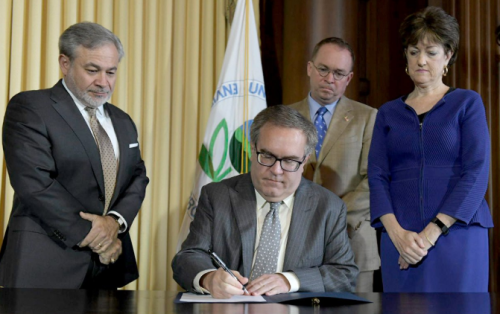Blog | Federal Investment
March 6, 2025
June 19, 2019 │ Andy Barnes, Program Manager, Clean Energy Business Network

On June 19, Environmental Protection Agency (EPA) Administrator Wheeler signed the final version of the Affordable Clean Energy (ACE) rule, the next step in developing the Trump Administration’s replacement to the Obama-era Clean Power Plan.
The Affordable Clean Energy rule establishes guidelines for states to develop carbon emissions reductions standards for existing coal-fired power plants.
What is the Affordable Clean Energy rule?
The Affordable Clean Energy rule (ACE) is a proposed rule by the Environmental Protection Agency that would establish guidelines for states to develop plans to reduce carbon emissions from existing coal-fired power plants. The rule identifies “on-site efficiency upgrades” at these plants as the “best system of emission reduction” for reducing carbon emissions at roughly 600 coal plants located at approximately 300 facilities across the country.
The rule also identifies candidate technologies that states can choose from when developing plans. Once the rule is finalized, states will have three years to develop plans that set performance standards for existing coal-fired power plants and the associated emissions reduction targets. In the event that a state fails to develop a sufficient plan, EPA would have two years to develop a federal plan to set performance standards for that state.
How is the Affordable Clean Energy Rule different than the Clean Power Plan?
While there are extensive differences between the two rules, at the highest level, ACE and CPP differ on level of authority given to states, ambition of carbon emissions reductions, scope, and timing.
Federal vs State Authority:
The CPP established carbon reductions targets for states and allowed them to develop their own plans to achieve those targets. The ACE rule establishes guidelines for states to set performance standards for affected electric generating units and create plans to reach those goals.
CO2 Emission Reduction Targets:
When finalized in 2015, the CPP aimed to achieve a 32% reduction in national power sector CO2 emissions by 2030. Updated projections from EPA in the new rule suggest the CPP would have achieved 36% reductions by 2030 and implementation of ACE will result in a 34% drop in emissions. One reason the ACE would have such a modest impact is a result of progress in power sector CO2emissions since the CPP was finalized in 2015; the U.S. has already achieved 87.5% of the emissions reductions required under the Clean Power Plan, (with a reduction of 28% in 2017 over 2005 levels), according to data from the 2018 Sustainable Energy in America Factbook.
Scope of BSER:
The CPP established carbon emissions reduction targets in the electricity sector through the implementation of three building blocks: (1) efficiency improvements at coal plants, (2) fuel switching from coal to natural gas, and (3) swapping higher emitting coal generation for zero-emitting generation like solar and wind. Thus, the CPP allowed both onsite (or “inside-the-fence”) measures as well as offsite (“outside-the-fence”) generation-shifting measures to be used in achieving emissions reductions.
The EPA is now arguing that these “outside-the-fence” measures are beyond its authority under the Clean Air Act, so the ACE focuses only on the first building block: efficiency improvements at coal plants.
Timing:
The ACE rule increases the length of the rulemaking timeline at each stage of the process:
-States now have 3 years to submit plans once the rule is finalized (for CPP, this period was 9 months)
-EPA now has 12 months to take action on state plans (for CPP, 4 months)
-EPA now has 2 years to develop a federal plan after disapproval of a state plan, EPA would then implement the federal plan (for CPP, 6 months)
In total the length of time for developing state plans after the rule is finalized increases from 13-18 months under CPP to 4-6 years under the ACE rule.
See the EPA’s comparison of the two rules for more information.
How is the final ACE rule different than the proposed rule released in 2018?
The proposed rule amended the New Source Review air permitting program. The previous version would have allowed power companies seeking to renovate an existing power plant to use an hourly-based accounting method rather than an annual one for determining emissions impacts. This accounting shift could have led to fewer regulatory thresholds being triggered when efficiency improvements are made. EPA has removed changes to the NSR program in the final ACE rule and has signaled it will publish plant-specific changes to the NSR over the next few months on a separate regulatory track.
For a more detailed review of the Clean Power Plan, click here.
###
The Clean Energy Business Network (CEBN) is the small business voice of the clean energy economy, working to enhance opportunities for clean energy providers through policy support, market and technology information, and business development. Started in 2009 by The Pew Charitable Trusts, the CEBN is now a small business division of the Business Council for Sustainable Energy. The CEBN represents 3,000+ business leaders across all 50 U.S. states working with a broad range of clean energy and transportation technologies.